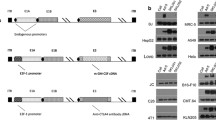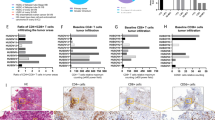Summary
We studied the biological responses of six ovarian cancer patients after intraperitoneal (i.p.) injections of virus-modified tumor cell extracts (VMTE) and autologous peripheral blood mononuclear cells, collected by leukapheresis after two injections of VMTE. VMTE was prepared from allogeneic ovarian cell lines, OV2774 and CaOV3, modified by influenza virus, A/PR8/34. A dose of 9 mg VMTE was given i.p. in total of 2–4 injections, and (1−9) × 108 autologous mononuclear cells were infused i.p., 24 h after the second VMTE injection, and 24 h and 72 h after the third VMTE injection. Both peripheral blood (PB) and peritoneal cavity (PC) effector cell cytotoxicity was significantly enhanced against the K562 cell line in the majority of patients, 24–48 h after the second and third VMTE injections. This was accompanied by a dramatic influx of neutrophils into PC (57-550-fold), increase in absolute numbers of lymphocytes, (including large granular lymphocytes) and monocytes, and resulted also in a significant decrease in the number of ascitic tumor cells (98% reduction). The infusion of autologous mononuclear cells did not appear to influence either cytotoxicity or cell infiltration of the peritoneal cavity. We also investigated the in vitro effect of recombinant interleukin-2 (IL-2) on effector cells from PB and PC from patients before and after VMTE treatment. Cytotoxicity of both of these compartments was significantly potentiated after culture with IL-2. In three out of five VMTE-treated patients, PC cytotoxicity was significantly higher after activation with IL-2 than that of patients before VMTE treatment. These data suggest that VMTE induces regional cellular immunity, which could be further potentiated by culture of PC effector cells with IL-2. Thus, combination of VMTE and IL-2 after regional administration could represent the effective therapy for patients with advanced ovarian cancer.
Similar content being viewed by others
References
Austin FC, Boone CW (1979) Virus augmentation of the antigenicity of tumor cell extracts. Adv Cancer Res 30: 301
Freedman RS (1984) Intraperitoneal immunotherapy in a patient with ovarian carcinoma. Cancer Bull 36: 250
Freedman RS, Bowen JM, Herson JH, Wharton JT, Edwards CL, Rutledge FN (1983) Immunotherapy for vulvar carcinoma with virus-modified homologous extracts. Obstet Gynecol 62: 707
Freedman RS, Bowen JM, Atkinson EN, Scott W, Wagner S (1984) Virus-augmented delayed hypersensitivity skin tests in gynecological malignancies. Cancer Immunol Immunother 17: 142
Kedar E, Ikejiri BL, Bonnard GD, Herberman RB (1982) A rapid technique for isolation of viable tumor cells from solid tumors: use of the tumor cells for induction and measurement of cell-mediated cytotoxic responses. Eur J Cancer Clin ncol 18: 991
Lichtenstein A (1987) Antitumor effect of the streptococcal preparation OK-432 in a murine model of ovarian cancer. Cancer Immunol Immunother 24: 172
Lichtenstein AK, Kahle J, Berek J, Zighelboi J (1984) Successful immunotherapy with intraperitonealCorynebacterium parvum in a murine ovarian cancer model is associated with the recruitment of tumor-lytic neutrophils into the peritoneal cavity. J Immunol 133: 519
Lotzová E (1986) Therapeutic possibilities of virus-modified tumor cell extracts and interleukin-2 in human ovarian cancer. Nat Immun Cell Growth Regul 5: 277
Lotzová E (1987) Human natural killer cells: their role and possible therapeutic application in leukemia. Clin Immunol Newsl 8: 56
Lotzová E (1987) Interleukin-2-generated killer cells, their characterization and role in cancer therapy. Cancer Bull 39: 30
Lotzová E, Savary CA (1984) Stimulation of NK cell cytotoxic potential of normal donors by two species of recombinant alpha interferon. J Interferon Res 4: 201
Lotzová E, Savary CA, Freedman RS, Bowen JM (1984) Natural killer cell cytotoxic potential of patients with ovarian carcinoma and its modulation with virus-modified tumor cell extract. Cancer Immunol Immunother 17: 124
Lotzová E, Savary CA, Herberman RB (1987) Induction of NK cell activity against fresh human leukemia in culture with interleukin 2. J Immunol 138: 2718
Lotzová E, Savary CA, Freedman RS, Edwards CL, Wharton JT (1988) Recombinant IL-2 activated NK cells mediate LAK activity against ovarian cancer. Int J Cancer 42: 225
Ozols RF, Young RC (1984) Chemotherapy of ovarian cancer. Semin Oncol 11: 251
Savage HE, Rossen RD, Hersh EM, Freedman RS, Bowen JM, Plager C (1986) Antibody development to viral and allogeneic tumor cell-associated antigens in patients with malignant melanoma and ovarian carcinoma treated with lysates of virus-infected tumor cells. Cancer Res 46: 2127
Sinkovics JG (1977) Immunotherapy with viral oncolysates for sarcoma. Letter. JAMA 237: 869
Timonen T, Saksela E, Ranki A, Hagry P (1977) Fractionation morphological and functional characterization of effector cells responsible for human natural killer activity against cell-line targets. Cell Immunol 48: 133
Timonen T, Ortaldo JR, Herberman RB (1981) Characterization of human large granular lymphocytes and relationship to natural killer and K cells. J Exp Med 153: 569
Uchida A, Micksche M (1983) Lysis of fresh human tumor cells by autologous peripheral blood lymphocytes and pleural effusion lymphocytes activated by OK432. JNCI 71: 673
Author information
Authors and Affiliations
Rights and permissions
About this article
Cite this article
Furukawa, K., Lotzová, E., Freedman, R.S. et al. Effect of virus-modified tumor cell extracts, autologous mononuclear cell infusions and interleukin-2 on oncolytic activity of effector cells of patients with advanced ovarian cancer. Cancer Immunol Immunother 30, 126–132 (1989). https://doi.org/10.1007/BF01665964
Received:
Accepted:
Issue Date:
DOI: https://doi.org/10.1007/BF01665964




